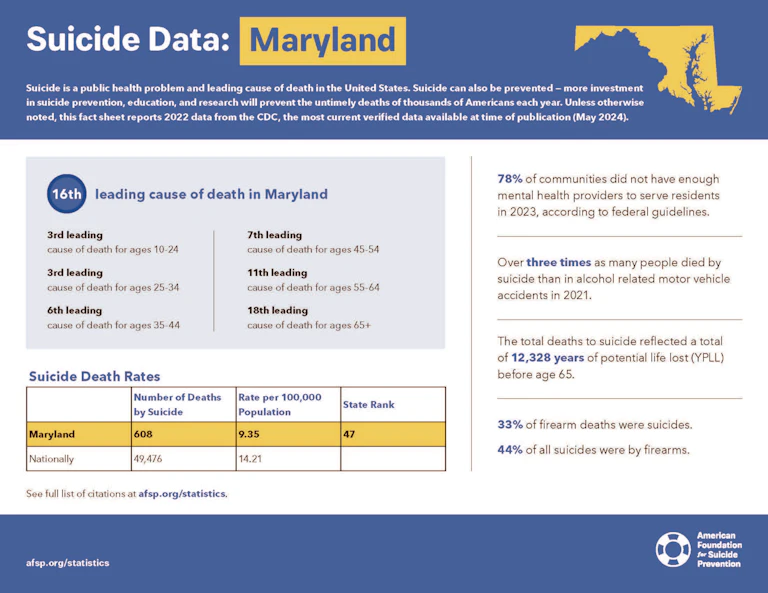Maryland
Maryland suicide prevention plans and initiatives
The Maryland Governor’s Commission on Suicide Prevention was originally established by a 2009 executive order and then amended by a 2018 executive order to help modernize the Commission by expanding membership and aligning objectives with current trends. The Maryland Suicide Prevention Program is housed within the state’s Department of Health and aims to prevent suicide by collaborating with the Governor’s Commission as well as various state departments, community agencies, providers, and members to increase awareness of suicide and improve preparedness to identify individuals at-risk, intervene, and provide support to promote healing and improved quality of life.
As of the 2018 amendment, the Commission is charged to submit a two-year plan to the Governor that establishes – for the organization, delivery, and funding of suicide prevention, intervention, and post-suicide services – the (1) emerging needs, (2) priorities and strategies, (3) promising practices and programs, (4) recommendations for coordination and collaboration among State agencies, and (5) training. Maryland’s State Suicide Prevention Plan 2020 was developed in consideration of the priorities and strategies in plans established by local jurisdictions.
Maryland laws
Key:
- Required by law
- Encouraged by law
- No law in place
Crisis lines and 988 implementation
- Addresses 988 infrastructure and provides for telecom user fee
- Addresses 988 infrastructure but does not include telecom user fee
- 988 law limited to creating an exploratory commission, advisory committee, or task force
Mental health parity
- Public health plans (e.g., Medicaid) regularly submit parity compliance analyses to state regulators
- Private health plans (individual and group) regularly submit parity compliance analyses to state regulators
K – 12 school suicide prevention
- Inclusion of the 988 Suicide & Crisis Lifeline and/or other crisis line(s) on student ID cards
- Student allowances for excused mental health absences
- School personnel must report student suicide risk to a parent and/or guardian
- Suicide prevention and/or mental health training for certain school personnel, annual
- Suicide prevention and/or mental health training for certain school personnel, not annual
- Suicide prevention, intervention, and postvention policies/programming
- Student education on suicide prevention
- Student education on mental health
Health professional training in suicide assessment, treatment and management
- Mental health professionals receive regular training
- Mental health professionals receive one time training
- Medical/surgical professionals receive regular training
- Medical/surgical professionals receive one time training
Conversion therapy bans
- Prohibits licensed/board certified mental health providers from engaging in conversion therapy with minors under 18 years of age
- Prohibits licensed/board certified mental health providers from engaging in conversion therapy with vulnerable adults
- Prohibits use of state funds for any purpose related to conversion therapy (e.g., conducting, making a referral for, or extending health benefits coverage for)
University and college campus suicide prevention
- Inclusion of the 988 Suicide & Crisis Lifeline and/or other crisis line(s) on student ID cards
- Students receive information on available mental health and/or suicide prevention services and/or resources
- Adoption of suicide prevention/awareness policy or program
